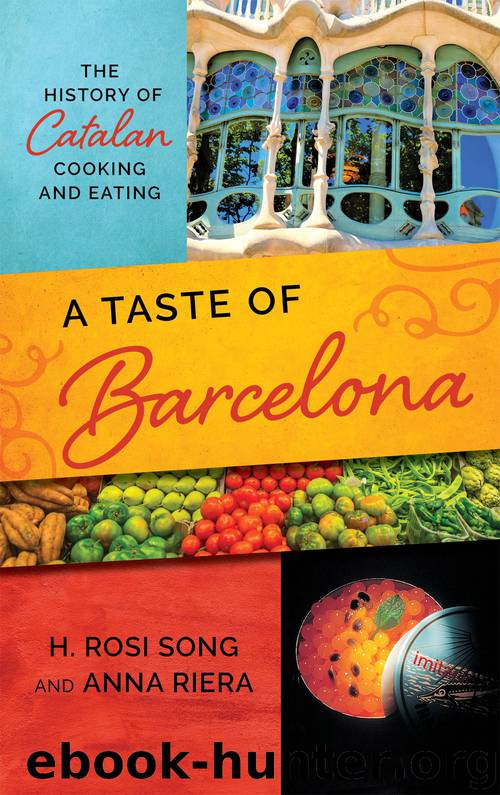A Taste of Barcelona: The History of Catalan Cooking and Eating by H. Rosi Song & Anna Riera

Author:H. Rosi Song & Anna Riera
Language: eng
Format: epub
Publisher: Rowman & Littlefield Publishers
Published: 2019-07-23T23:00:00+00:00
Entrance to La Boqueria market. Printed with permission from Bryn Mawr College; photograph by Kate McCann.
THE HISTORY OF FOOD MARKETS IN BARCELONA
There are currently thirty-nine public food markets distributed throughout the various neighborhoods in Barcelona.1 The list includes four non-food-related markets near the market halls, such as the large Sunday market next to Sant Antoni, which deals exclusively in books, magazines, postcards, and video games, and the flower market along Las Ramblas. Some of these markets are more popular among the visitors to the city than others. La Boqueria is clearly the most visited, but since its renovation in 2005, the Mercat de Santa Caterina, with its distinctive and colorful tile roofing, rivals La Boqueria in popularity.2 Another important market is the recently renovated Mercat de Sant Antoni, which opened in the summer of 2018. Tourists visit markets because of their history or gastronomic prestige (as well as their proximity to historic sites that are typically part of the tourist itinerary), but the residents’ relationships to the markets depend on their location and proximity to neighborhoods. Despite emerging later than in other European cities, Barcelona’s market halls have remained very much relevant until the present. They continue to draw attention from the local government, which remains committed to their renovation and to finding ways to revive the social role they play in the neighborhoods where they are located. In stark contrast to other historic market halls in the rest of Europe—and even in other cities in Spain—markets in Catalonia have become a strong part of its regional identity. From the first wrought-iron constructions built in 1876, they have developed into a polycentric system that today serves as a wide network of public covered markets.3
The building of market halls in Europe during the second half of the nineteenth century represented a new form of architecture and town planning. The technology that allowed the use of wrought-iron and glass in large quantities in the construction of buildings was perceived as a sign of modernity. The massive structures were seen as an expression of municipal pride, innovation, renovation, and the new edifices of commerce for capitalist cities.4 Although the construction of wrought-iron market halls in Barcelona would start later, the city began to work on providing space for their food markets during the first half of the 1800s. The municipal regulation of 1834 ensured the creation and the administration of public facilities that would function to provide food and drink for its inhabitants marked an important political moment for the city. It was the first time that the local government intervened to regulate a matter of its economy; from then on, the experience changed the role that the Catalan capital would play in its own affairs.5 When two convents burned down in 1835 along Las Ramblas during a popular rebellion, the city decided to use the lots to build its first two covered markets. Although the widespread anger that led to these acts of violence was connected to the ongoing Carlist Wars of the time, the underlying frustration was the poor living and labor conditions of the working class.
Download
This site does not store any files on its server. We only index and link to content provided by other sites. Please contact the content providers to delete copyright contents if any and email us, we'll remove relevant links or contents immediately.
| Eastern European | English, Scottish & Welsh |
| French | German |
| Greek | Hungarian |
| Irish | Italian |
| Mediterranean | Polish |
| Portuguese | Russian |
| Scandinavian | Spanish |
| Turkish |
Biscuits: A Savor the South Cookbook by Belinda Ellis(4290)
The French Women Don't Get Fat Cookbook by Mireille Guiliano(3609)
A Jewish Baker's Pastry Secrets: Recipes from a New York Baking Legend for Strudel, Stollen, Danishes, Puff Pastry, and More by George Greenstein(3546)
Better Homes and Gardens New Cookbook by Better Homes & Gardens(3528)
Ottolenghi Simple by Yotam Ottolenghi(3519)
Al Roker's Hassle-Free Holiday Cookbook by Al Roker(3499)
Trullo by Tim Siadatan(3382)
Bake with Anna Olson by Anna Olson(3357)
Hot Thai Kitchen by Pailin Chongchitnant(3321)
Panini by Carlo Middione(3254)
Nigella Bites (Nigella Collection) by Nigella Lawson(3174)
Momofuku by David Chang(3141)
Salt, Fat, Acid, Heat: Mastering the Elements of Good Cooking by Nosrat Samin(3108)
Modern French Pastry: Innovative Techniques, Tools and Design by Cheryl Wakerhauser(3076)
Best of Jane Grigson by Jane Grigson(2948)
Classic by Mary Berry(2943)
Solo Food by Janneke Vreugdenhil(2931)
Tapas Revolution by Omar Allibhoy(2929)
Ottolenghi - The Cookbook by Yotam Ottolenghi(2872)
